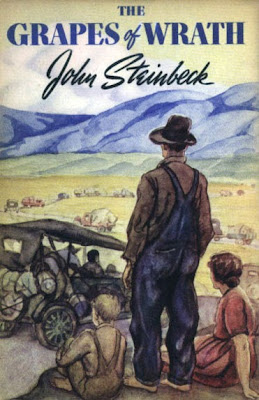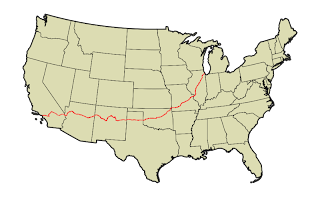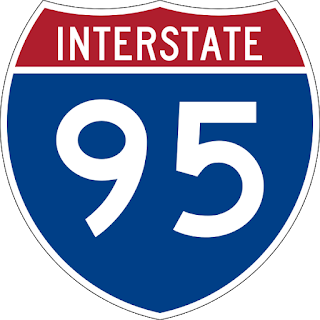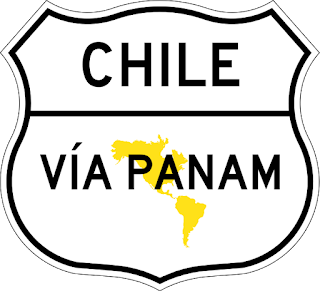The Early days and Hard Times in the 1920's and 1930's
"U.S. Route 66 (US 66 or Route 66), also known as the Will Rogers Highway and colloquially known as the Main Street of America or the Mother Road, was one of the original highways within the U.S. Highway System. Route 66 was established on November 11, 1926—with road signs erected the following year. The highway, which became one of the most famous roads in America, originally ran from Chicago, Illinois, through Missouri, Kansas, Oklahoma, Texas, New Mexico, and Arizona before ending at Los Angeles, California, covering a total of 2,448 miles (3,940 km). It was recognized in popular culture by both a hit song and the Route 66 television show in the 1960s.
Image from Wikipedia.
Route 66 served as a major path for those who migrated west, especially during the Dust Bowl of the 1930s, and it supported the economies of the communities through which the road passed.People doing business along the route became prosperous due to the growing popularity of the highway, and those same people later fought to keep the highway alive in the face of the growing threat of being bypassed by the new Interstate Highway System.
Route 66 underwent many improvements and realignments over its lifetime, and it was officially removed from the United States Highway System on June 27, 1985 after it had been replaced in its entirety by the Interstate Highway System. Portions of the road that passed through Illinois, Missouri, New Mexico, and Arizona have been designated a National Scenic Byway of the name "Historic Route 66", which is returning to some maps. Several states have adopted significant bypassed sections of the former US 66 into the state road network as State Route 66."
 |
| Image from Wikipedia. |
 |
| Image from Wikipedia. |
The Golden Era of the the 1940's and 1950's
Changes in farming methods and weather patterns finally began to ease the tragedy of the Dust Bowl. Then World War II began with the attack on Pearl Harbor that destroyed a large part of the United States Pacific fleet. Indirectly, this would deepen the emotional ties between Route 66 and the American public. The loss of of the fleet required rebuilding. This meant jobs on the west coast. Shipyards and also airplane factories were going full tilt and a literal army of steel workers relocated from the midwest to do those jobs. Also heading west were sailors and soldiers headed of to fight in the pacific theater. While many came by rail, not a small number came by the highway. Services along the way were improved from the 1930's However the emotion of war added a depth to the trips west made by so many.
Post-War Boom Time
After the war was over, there was a lot of movement around the country as people began to enjoy the post-war prosperity. So many of the iconic Route 66 sites were from this period in the lates 40's into the 1950's. The Mother Road had become a river of neon with all of the modern conveniences of the day readily available.
This clip gives an idea of the road during that era:
The Song
It was during this golden era that Bobby Troup wrote the legendary song that Nat King Cole made famous about the highway. From Wikipedia:
(Wikimedia Commons/CC) "(Get Your Kicks on) Route 66", often rendered simply as "Route 66", is a popular song and rhythm and blues standard, composed in 1946 by American songwriter Bobby Troup. It was first recorded in the same year by Nat King Cole, and was subsequently covered by many artists including Chuck Berry in 1961, The Rolling Stones in 1964, Depeche Mode in 1987, Pappo's Blues in 1995, John Mayer in 2006, and Glenn Frey in 2012. The song's lyrics follow the path of the U.S. Route 66 highway, which used to run a long distance across the U.S., going from Chicago, Illinois, to Los Angeles, California.
The Bill That Ended It All
In 1956, Eisenhower signed the Federal-Aid Highway Act creating the interstate highway system and setting into play the apparent demise of the route. It took decades for the interstate highway system to be built and during that time the road was still a major route. As the interstates were built, older highways like Route 66 were frequently bypassed to allow for high speed through traffic. The small businesses that lined the road were now on a secondary road to the main highway and slowly but surely the road began to wither and die.
The Television Series
 |
| (Wikimedia Commons/CC) |
Before that happened though, CBS television did its part to add to the lore and legend of the road. From Wikipedia:
"Route 66 is an American TV series in which two young men traveled across America in a Chevrolet Corvette sports car. The show ran weekly on Fridays on CBS from October 7, 1960 to March 20, 1964. It starred Martin Milner as Tod Stiles and, for the first two and a half seasons, George Maharis as Buz Murdock. Maharis was ill for much of the third season, during which time Tod was shown traveling on his own. Tod met Lincoln Case, played by Glenn Corbett, late in the third season, and traveled with him until the end of the fourth and final season. The series currently airs on Me-TV, My Family TV and RTV.
Among the series more notable aspects were the featured Corvette convertible, and the program's instrumental theme song (composed and performed by Nelson Riddle), which became a major pop hit."
The Decline and Revival from the 1960's to the present
 |
| Image from Wikipedia. |
Into the 1970's and 1980's the road had become a sort of ghost town. Its colorful strips of neon had turned to sun bleached faded paint and boarded up store fronts. But the old highway had gained such a foothold in the American imagination that a movement began to save it. Slowly, and this is still happening, the old businesses began to be revived and tourism came to experience the great American highway as it was in perhaps its most vibrant times.
The story of the highway has become such a part of the American
 |
| Image from Wikipedia. |
it.
The future looks bright for the old highway, with its recent publicity as well as a popular movement to preserve the remnants of a golden age in American history are likely to add to its legends as new generations create their own memories on this famous strip of asphalt.
And Now A Word From Our Sponsor...
If you like what you have read here I'd like to ask you a favor. If you purchase any item on Amazon after you link to them in the Amazon banner below, I will get a little something from them. It doesn't cost you any extra and I cannot see what you have purchased.
With your help, I can keep the show on the road for you.
With your help, I can keep the show on the road for you.
You Can Give me a Karma Donation Via PayPal
Keep Traveling!
To read more Old Highway Notes, choose an off ramp and click on the highway sign:
Vista Points
Be social, Get more info, View our YouTube playlist and more












No comments :
Post a Comment